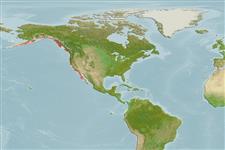Environment: milieu / climate zone / depth range / distribution range
Ecology
Marine; demersal; depth range 0 - 15 m (Ref. 2850). Subtropical
Northeast Pacific: Sitka, Alaska to southern British Columbia, Canada and to Baja California, Mexico.
Size / Weight / Age
Maturity: Lm ? range ? - ? cm
Max length : 13.0 cm TL male/unsexed; (Ref. 2850)
Dorsal spines (total): 0; Dorsal soft rays (total): 28 - 30; Anal spines: 0; Anal soft rays: 22 - 24. Dorsal fin with 2 parts, the first short, low and rounded, the second with longer rays that almost reach the caudal. Caudal narrow with rounded end. Ventral lobe of pectorals with thick exserted longer rays.
Occurs from intertidal areas to 15 m depth, but usually not in tide pools (Ref. 2850).
Life cycle and mating behavior
Maturity | Reproduction | Spawning | Eggs | Fecundity | Larvae
Eschmeyer, W.N., E.S. Herald and H. Hammann, 1983. A field guide to Pacific coast fishes of North America. Boston (MA, USA): Houghton Mifflin Company. xii+336 p. (Ref. 2850)
IUCN Red List Status (Ref. 130435: Version 2024-1)
Threat to humans
Harmless
Human uses
Fisheries: of no interest
Tools
Special reports
Download XML
Internet sources
Estimates based on models
Preferred temperature (Ref.
123201): 8.7 - 17.9, mean 10.7 °C (based on 200 cells).
Phylogenetic diversity index (Ref.
82804): PD
50 = 0.5000 [Uniqueness, from 0.5 = low to 2.0 = high].
Bayesian length-weight: a=0.00525 (0.00237 - 0.01161), b=3.15 (2.96 - 3.34), in cm total length, based on LWR estimates for this (Sub)family-body shape (Ref.
93245).
Trophic level (Ref.
69278): 3.4 ±0.6 se; based on size and trophs of closest relatives
Resilience (Ref.
120179): High, minimum population doubling time less than 15 months (Preliminary K or Fecundity.).
Fishing Vulnerability (Ref.
59153): Low vulnerability (10 of 100).
